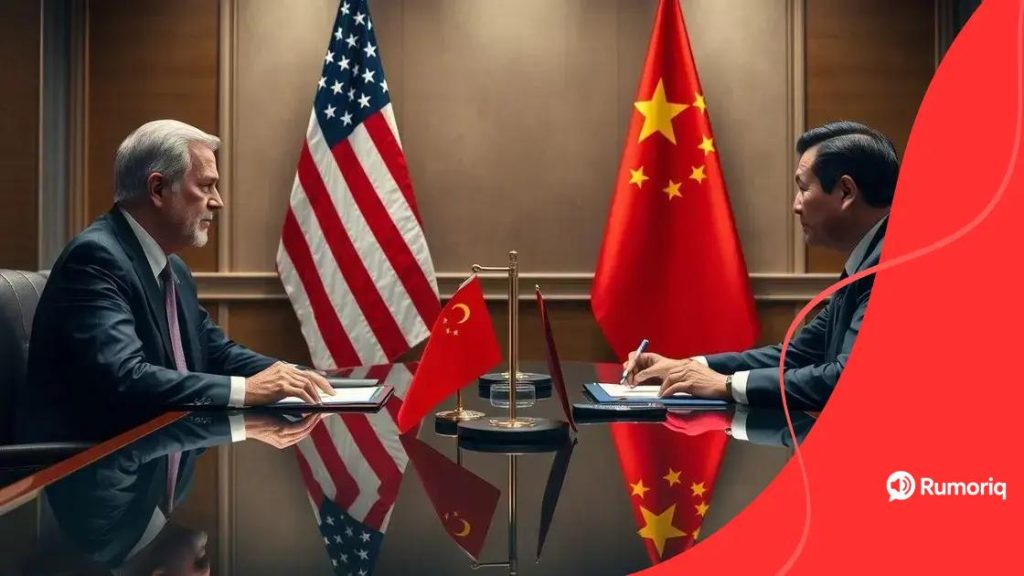US-China relations developments: what to watch in 2024

Anúncios
US-China relations significantly shape global alliances, influencing countries to realign based on economic interests, security concerns, and shared challenges like climate change.
US-China relations developments are shaping the future of international politics and economics. With rising tensions and collaborations, it’s essential to understand how these dynamics affect us all.
Anúncios
Recent milestones in US-China diplomacy
In recent years, US-China relations have seen significant milestones that have transformed diplomatic ties. These developments are crucial for understanding how both nations navigate a complicated relationship filled with competition and cooperation.
One notable milestone was the 2021 trade agreement that sought to ease tensions over tariffs and trade imbalances. The goals were clear: to ensure fair practices while addressing concerns over intellectual property theft.
Key Events in Diplomacy
Since then, several key events have shaped the diplomatic landscape:
Anúncios
- Bilateral talks have increased, focusing on climate change and public health crises.
- The leaders of both nations have held summits to address security concerns in the Asia-Pacific region.
- Military cooperation has been discussed to manage tensions in the South China Sea.
Additionally, the introduction of cultural exchanges has been a refreshing step towards mutual understanding. These exchanges help foster goodwill and build relationships outside of mere political maneuvering.
As the world watches, the dynamics of US-China relations will continue to evolve, driven by the economic ambitions and political strategies of both countries. The recent establishment of communication channels to discuss contentious issues has shown promise in navigating complex matters.
Looking forward, analysts predict that ongoing engagements will focus on technology, trade, and environmental commitments. Each of these areas poses its challenges but represents an opportunity for collaboration that might create a more balanced diplomatic framework.
Impact of trade policies on global markets
The impact of trade policies on global markets is profound. These policies can shape economies and influence relationships between countries. For example, tariffs and trade agreements are key tools that nations use to guard their interests and promote commerce.
Countries often implement trade tariffs to protect local industries. This can boost domestic production, but it might lead to higher prices for consumers. Additionally, the repercussions often extend beyond borders, affecting international supply chains.
Key Effects of Trade Policies
Understanding the implications of trade policies can help shed light on their broader effects:
- Price fluctuations in imported goods, which may affect inflation rates.
- Job creation or losses in certain sectors depending on the industries protected or hurt by tariffs.
- Innovation incentives that arise from competition among domestic and foreign companies.
The evolution of US-China trade policies specifically highlights how interconnected and fragile these dynamics can be. Each decision made by either country sends ripples throughout the global economy. Recent changes, like the Phase One Trade Agreement, aimed to reduce tensions and stabilize the market.
In addition to tariffs, trade policies may also include quotas and import restrictions, which are intended to limit the quantity of goods that are brought into a country. These measures can protect new industries, but they may also limit choices for consumers and lead to trade disputes.
Technological competition between the US and China

The technological competition between the US and China has intensified significantly in recent years. As both countries strive for technological supremacy, this rivalry impacts global markets, economies, and security.
In the field of artificial intelligence, both nations are investing heavily. The US emphasizes innovation and research, while China focuses on application and implementation. This creates a fast-paced environment where advancements are rapidly adopted in everyday life.
Key Areas of Competition
Several critical areas define this technological rivalry:
- 5G technology deployment, with both countries racing to lead in communication infrastructure.
- Cybersecurity measures, where both nations work to protect their data and intellectual property.
- Quantum computing, a field that promises to revolutionize computing power and security.
Additionally, initiatives like the US CHIPS Act aim to boost domestic semiconductor production, counteracting China’s advancements in chip manufacturing. These efforts are vital, as microchips are essential for countless modern technologies.
The race for technological leadership has broader implications, influencing international alliances and economic relations. As countries assess their partnerships, the balance of power is shifting in response to these technological achievements.
Moreover, education and talent development play a critical role in this competition. Both nations are nurturing their workforce in STEM fields to secure future advancements. This investment in human capital ensures that the competition will only grow fiercer in the coming years.
Public perception of US-China relations
The public perception of US-China relations plays a crucial role in shaping the way both countries interact on the global stage. In recent years, the views of people in both nations have shifted significantly due to various events, including trade wars, diplomatic conflicts, and cultural exchanges.
Surveys often reveal growing concerns among the public regarding security and economic competition. Americans frequently cite China’s economic policies as a major issue, leading to a more negative view of China. Conversely, many Chinese citizens may feel that the US is unfairly criticizing their country.
Factors Influencing Perception
Several factors contribute to shaping public attitudes toward this relationship:
- Media coverage that often highlights tensions and disagreements, rather than cooperation.
- Educational exchanges allowing students to study in each country, fostering understanding.
- Government messaging that can frame discussions around patriotism and national interests.
As social media continues to grow, younger generations are affected differently than older ones. Younger people might have a more balanced view due to exposure to diverse opinions and experiences. This generational gap can lead to varied perceptions of what US-China relationships mean and how they should evolve.
Moreover, economic ties, such as trade and investment, can influence public sentiment. While American companies benefit from accessing China’s vast market, many still worry about job security back home. On the other side, Chinese citizens are keenly aware of how US policies can impact their economy and daily life.
Future implications for global alliances
The future implications for global alliances in light of US-China relations are significant and complex. As both powers navigate their rivalry, the impact on international partnerships will be profound and far-reaching.
One major consideration is how countries will align themselves based on their economic interests. Nations may seek closer ties with either the US or China, depending on which country offers better trade deals or investment opportunities. This shifting dynamic can reshape long-standing alliances.
Key Considerations for Alliances
Several factors will influence future global alliances:
- Security agreements, as nations seek protection from perceived threats.
- Economic partnerships, where countries focus on mutual benefits for trade and investment.
- Cultural exchanges that foster understanding and cooperation between diverse nations.
As tensions rise, countries may also consider forming new alliances to counterbalance influences. The emergence of coalitions focusing on shared interests could redefine global power dynamics. For instance, nations in Southeast Asia may collaborate more closely to address their economic concerns and security challenges.
Furthermore, the impact of global issues such as climate change cannot be ignored. Nations might find common ground in working together to tackle these challenges, leading to alliances based more on shared values rather than geographic proximity or economic gain. This approach may influence how countries interact with both the US and China.
\n
FAQ – Questions about US-China Relations and Global Alliances
How do US-China relations affect global partnerships?
US-China relations significantly influence global partnerships, as countries may align themselves based on economic or security interests.
What role does public perception play in international relations?
Public perception shapes how governments approach diplomacy and can impact their decisions regarding alliances and negotiations.
Why are security agreements important in this context?
Security agreements help nations protect themselves against perceived threats, making them a priority in the evolving landscape of US-China relations.
How can climate change influence global alliances?
Climate change can lead to countries collaborating and forming alliances based on shared goals and the need for cooperative solutions.